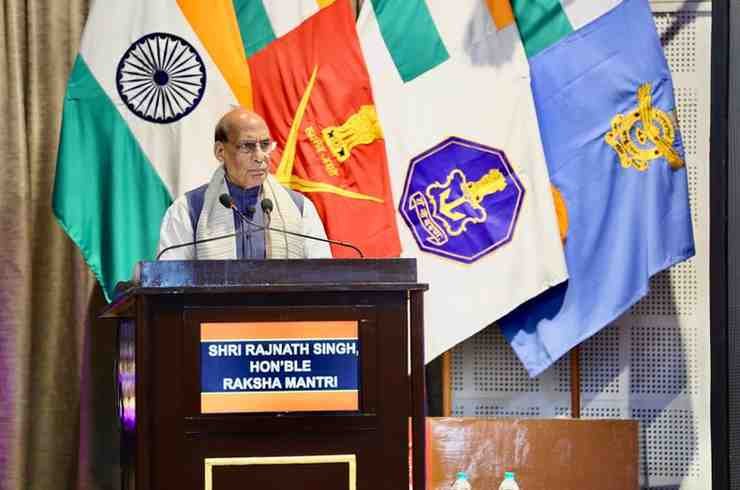Madhya Pradesh: Defence Minister Rajnath Singh on Wednesday underscored national security as the foremost priority of the government, stressing that modern warfare is becoming increasingly unpredictable due to rapid technological advancements and the element of surprise.
He addressed the plenary session of RAN SAMWAD, the first-ever tri-service seminar on war, warfare, and warfighting, organised at the Army War College, Dr Ambedkar Nagar, Madhya Pradesh.
Singh highlighted that future conflicts will not be confined to traditional domains but will extend into outer space and cyberspace, requiring India to remain prepared for innovations while mastering existing technologies.
“Wars of tomorrow will not just be fought with weapons. They will be a combination of technology, intelligence, economy, and diplomacy. The nation that masters the triangle of technology, strategy, and adaptability will emerge as a true global power,” he said.
Technology and Surprise in Modern Warfare
The Defence Minister emphasised that sheer numbers of soldiers or stockpiles of weapons are no longer sufficient. Instead, precision-guided systems, artificial intelligence, cyber warfare, unmanned aerial vehicles, and real-time intelligence will shape the battlefield.
“Technology evolves so fast that before one innovation is fully absorbed, another emerges, completely changing the rules of conflict. Unmanned drones, hypersonic missiles, cyberattacks, and AI-driven decisions are redefining warfare. Surprise has become formless, ever-changing, and decisive,” Singh said.
He asserted that whichever nation defines the battlefield controls the conflict. “Our effort must be to decide the battlefield and compel the adversary to fight on our terms. This ensures we hold the advantage,” he remarked, citing the success of Operation Sindoor as a striking example of technology-driven warfare.
Lessons from Operation Sindoor
Recalling the swift and precise actions of the Indian Armed Forces against terrorists in Pakistan, Singh described the operation as “something the adversary could never have imagined.” He said the mission highlighted the importance of information and cyber warfare, quick logistics, and seamless integration among the three services.
He added that the bravery of soldiers, coupled with advanced surveillance and intelligence capabilities, showcased how indigenous technology and jointness can determine the outcome of a conflict. Singh particularly praised the strengthening of cyber and information infrastructure as vital to future readiness.
Focus on Training and Modernisation
Acknowledging the Army’s plan to provide drone training to all jawans by 2027, Singh termed it a “game-changing step.” He also welcomed the creation of new specialised units such as the Rudra Brigade, ShaktiBaan Regiment, Divyastra Battery, Drone Platoon, and Bhairav Battalion.
He reiterated the government’s focus on Aatmanirbharta (self-reliance), calling Operation Sindoor a testimony to the success of indigenous weapons and platforms. Singh pointed out that India, once a major defence importer, is now emerging as a reliable exporter.
“Today, platforms such as Light Combat Aircraft Tejas, Akash Missile System, Advanced Towed Artillery Gun, and the Indigenous Aircraft Carrier are standing tall at global standards. We have advanced towards producing fifth-generation fighter aircraft and developing jet engines within the country,” he said.
Defence Production and Exports at Record Levels
The Defence Minister noted the record defence production of over ₹1.5 lakh crore in FY 2024-25, compared to ₹46,425 crore in 2014. Exports, he added, had touched ₹24,000 crore, up from less than ₹1,000 crore a decade ago.
“This progress is a symbol of India’s changing global identity. Today, the world sees the ‘Make-in-India’ label as an assurance of quality and trust. Self-reliance is no longer a slogan; it is the unbreakable foundation of our national security,” Singh asserted, while crediting both public and private sectors for the achievement.
Shielding the Nation with Sudarshan Chakra Mission
Referring to Prime Minister Narendra Modi’s Sudarshan Chakra Mission, Singh said it reflects the government’s resolve to defend the nation with a shield of indigenous modern technology. He lauded DRDO for its maiden test of an Integrated Air Defence Weapon System and a High-Powered Directed Energy Weapon.
On the naval front, Singh noted the induction of stealth frigates INS Himgiri and INS Udaygiri, underscoring the Navy’s robust role during Operation Sindoor in restricting enemy movement in the Arabian Sea. “Our Navy’s presence in the Indian Ocean ensures complete maritime security,” he said.
Preparedness for Long-Term Conflicts
Singh emphasised that India must prepare for any war that may last from months to years. “We must ensure sufficient surge capacity. National security cannot be limited to the Armed Forces alone; it requires a whole-of-nation approach,” he added.
He called upon industries, academia, media, technical institutes, and civil society to contribute to national security, stressing that economic strength, education, and communication systems are integral to modern defence.
“India has never sought war nor harboured aggressive intent. But if challenged, we will go to any extent to defend our land. We want peace, but peace is secured only through strength,” Singh affirmed.
Strengthening Joint Doctrine and Roadmap
At the seminar, the Defence Minister released the Joint Doctrine for Multi-Domain Operations, providing a blueprint for integrating the Armed Forces across land, sea, air, space, cyber, and cognitive domains. The doctrine is publicly available at http://ids.nic.in/content/doctrines.
Singh also unveiled the Technology Perspective and Capability Roadmap, outlining the long-term modernisation plan of the Armed Forces for the next decade. The roadmap aims to guide Indian industry and R&D institutions in aligning innovation and production with national defence needs, further reducing import dependence.
Participation at RAN SAMWAD
The event witnessed the participation of Chief of Defence Staff General Anil Chauhan, Navy Chief Admiral Dinesh K Tripathi, Air Chief Marshal AP Singh, Vice Chief of the Army Staff Lt Gen Pushpendra Singh, former service chiefs, defence attaches, industry leaders, scholars, and veterans.
Singh concluded by expressing confidence that the seminar’s deliberations would strengthen India’s defence strategy and contribute to long-term national security.
“The challenges are formidable, but India’s resolve and courage are greater. The world respects us not only for our strength but also for our commitment to peace, justice, and truth,” he said.








